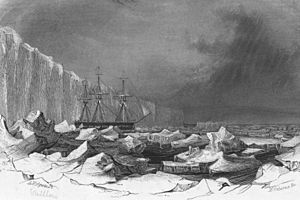Thomas A. Budd facts for kids
Quick facts for kids
Captain
Thomas A. Budd
|
|
|---|---|
| Born | April 28, 1818 |
| Died | March 22, 1862 (aged 43) Mosquito Inlet, Florida, United States |
| Allegiance | |
| Service/ |
|
| Years of service | 1829–1862 |
| Rank | |
| Commands held |
|
| Battles/wars | |
Thomas A. Budd (born April 28, 1818 – died March 22, 1862) was an officer in the United States Navy. He was known for his explorations and his service during the American Civil War.
Contents
Thomas Budd joined the U.S. Navy in 1829 as a midshipman, which was a junior officer rank. He quickly moved up, becoming a lieutenant in 1841.
Exploring the World

From 1838 to 1842, Budd was an important part of the United States Exploring Expedition. This was a huge journey led by Captain Charles Wilkes to explore the Pacific Ocean and Antarctica. Budd served on the ship USS Peacock and later on the main ship, USS Vincennes.
During this expedition, several places were named after him! These include Budd Coast in Antarctica, Budd Inlet in Puget Sound, and Washington Harbor (originally Budd's Harbor) in Sequim Bay, near the Strait of Juan de Fuca.
Adventures with Steamships
In the late 1840s, Thomas Budd became a commander for the Pacific Mail Steamship Company. He commanded the ship California during the exciting time of the California Gold Rush.
First Through the Straits
In 1848, under his command, the California made history. It became the first American steamship to travel through the Straits of Magellan. These narrow waterways are at the southern tip of South America.
Budd was asked to join Commodore Matthew C. Perry on his famous trip to Japan. However, he decided to leave the Navy before that journey began in 1853. Later, he moved to Buffalo, New York, where he worked in business.
Service in the Civil War
When the American Civil War began, Thomas Budd offered to serve the Union. He was given command of the gunboat USS Penguin.
Blockading the Coast
The Penguin first helped with the Union Blockade in the Atlantic Ocean. This blockade aimed to stop supplies from reaching the Southern states. Later, the Penguin joined the Potomac Flotilla, a group of ships protecting the Potomac River.
In October 1861, the Penguin moved to help with the blockade along the southern Atlantic coast. Budd and his ship took part in the bombardment of Hilton Head in November. During this battle, the Penguin was damaged. But Budd was brave! He ordered a tugboat to pull his ship closer so they could keep fighting.
Helping Others
In December 1861, Budd also helped enslaved people who had escaped around Edisto Island, South Carolina. He supported Union activities in that area.
Sadly, Thomas Budd was killed in a small fight at Mosquito Inlet in Florida on March 22, 1862. He was buried in Forest Lawn Cemetery in Buffalo, New York.
Personal Life
Thomas Budd was married and had children.
See also
 In Spanish: Thomas A. Budd para niños
In Spanish: Thomas A. Budd para niños

